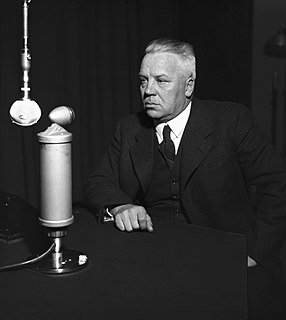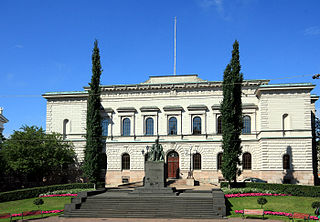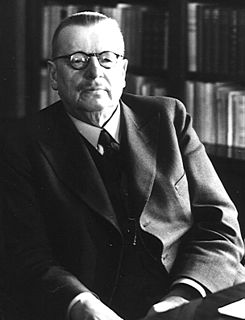
Juho Kusti Paasikivi was the seventh President of Finland (1946–1956). Representing the Finnish Party and the National Coalition Party, he also served as Prime Minister of Finland, and was an influential figure in Finnish economics and politics for over fifty years. He is remembered as a main architect of Finland's foreign policy after the Second World War.
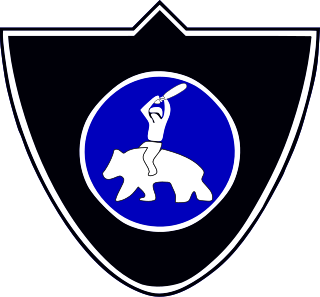
Patriotic People's Movement was a Finnish nationalist and anti-communist political party. IKL was the successor of the previously banned Lapuan liike. It existed from 1932 to 1944 and had an ideology similar to its predecessor, except that IKL participated in elections — with limited success.
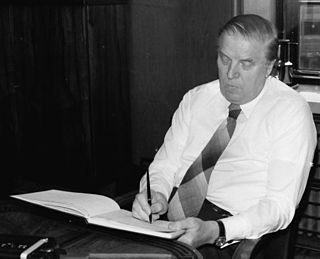
Johannes Virolainen was a Finnish politician and who served as 30th Prime Minister of Finland.

Karl-August Fagerholm was Speaker of Parliament and three times Prime Minister of Finland. Fagerholm became one of the leading politicians of the Social Democrats after the armistice in the Continuation War. As a Scandinavia-oriented Swedish-speaking Finn, he was believed to be more to the taste of the Soviet Union's leadership than his predecessor Väinö Tanner. Fagerholm's post-war career was however marked by fierce opposition from both the Kremlin and domestic communists. He narrowly lost the presidential election to Urho Kekkonen in 1956.

Kustaa Rafael Paasio was a prominent Finnish politician and editor from Social Democratic Party. He served as Prime Minister of Finland twice.
Parliamentary elections were held in Finland on 17 and 18 March 1945. The broad-based centre-left government of Prime Minister Juho Kusti Paasikivi remained in office after the elections.
Parliamentary elections were held in Finland on 6 and 7 July 1958. The communist Finnish People's Democratic League emerged as the largest party, but was unable to form a government.
Peace opposition (Rauhanoppositio) was a Finnish cross-party movement uniting both bourgeois politicians like Paasikivi, Kekkonen, Sakari Tuomioja etc. and social democrats, aiming at stepping out of the Continuation war and finding a way to conclude peace with the Soviet Union. The number of MPs belonging to this group was rather small at first, but it gained influence as the military situation worsened. After the signing of armistice, Paasikivi established his cabinet, which included members of the previous opposition group.
Parliamentary elections were held in Finland on 1 and 2 July 1936. Following the election Prime Minister Toivo Mikael Kivimäki of the National Progressive Party was defeated in a confidence vote in September 1936 and resigned in October. Kyösti Kallio of the Agrarian League formed a centrist minority government after Pehr Evind Svinhufvud refused to allow the Social Democrats to join the government. After Svinhufvud's defeat in the February 1937 presidential election, Kallio took office as the new President in March 1937, and he allowed the Social Democrats, Agrarians and Progressives to form the first centre-left or "red soil" Finnish government. Aimo Cajander (Progressive) became Prime Minister, although the real strong men of the government were Finance Minister Väinö Tanner and Defence Minister Juho Niukkanen (Agrarian).
Parliamentary elections were held in Finland on 1 and 2 July 1951.
Parliamentary elections were held in Finland on 2 and 3 January 1972.

Two-stage presidential elections were held in Finland in 1982. The public elected presidential electors to an electoral college on 17 and 18 January. They in turn elected the President. The result was a victory for Mauno Koivisto, the first member of the Social Democratic Party to be elevated to the country's highest post, and his election meant the full integration of Social Democrats into Finnish public life and an end to the postwar dominance of the Centre Party.

The Social Democratic Party of Finland, shortened to the Social Democrats, is a social-democratic political party in Finland. The party holds 35 seats in Finland's parliament. The party has set many fundamental policies of Finnish society during its representation in the Finnish Government. Founded in 1899, the SDP is Finland's oldest active political party. The SDP has a close relationship with Finland's largest trade union, SAK, and is a member of the Socialist International, the Party of European Socialists, and SAMAK.

Two-stage presidential elections were held in Finland in 1950, the first time the public had been involved in a presidential election since 1937 as three non-popular elections had taken place in 1940, 1943 and 1946. On 16 and 17 January the public elected presidential electors to an electoral college. They in turn elected the President. The result was a victory for Juho Kusti Paasikivi, who won on the first ballot. The turnout for the popular vote was 63.8%. President Paasikivi was at first reluctant to seek re-election, at least in regular presidential elections. He considered asking the Finnish Parliament to re-elect him through another emergency law. Former President Ståhlberg, who acted as his informal advisor, persuaded him to seek re-election through normal means when he bluntly told Paasikivi: "If the Finnish people would not bother to elect a President every six years, they truly would not deserve an independent and democratic republic." Paasikivi conducted a passive, "front-porch" style campaign, making few speeches. By contrast, the Agrarian presidential candidate, Urho Kekkonen, spoke in about 130 election meetings. The Communists claimed that Paasikivi had made mistakes in his foreign policy and had not truly pursued a peaceful and friendly foreign policy towards the Soviet Union. The Agrarians criticized Paasikivi more subtly and indirectly, referring to his advanced age, and speaking anecdotally about aged masters of farmhouses, who had not realized in time that they should have surrendered their houses' leadership to their sons. Kekkonen claimed that the incumbent Social Democratic minority government of Prime Minister K.A. Fagerholm had neglected the Finnish farmers and the unemployed. Kekkonen also championed a non-partisan democracy that would be neither a social democracy nor a people's democracy. The Communists hoped that their presidential candidate, former Prime Minister Mauno Pekkala, would draw votes away from the Social Democrats, because Pekkala was a former Social Democrat. The Agrarians lost over four per cent of their share of the vote compared to the 1948 parliamentary elections. This loss ensured Paasikivi's re-election. Otherwise Kekkonen could have been narrowly elected President - provided that all the Communist and People's Democratic presidential electors would also have voted for him.

Two-stage presidential elections were held in Finland in 1956. On 16 and 17 January the public elected presidential electors to an electoral college. They in turn elected the President. The result was a victory for Urho Kekkonen, who won on the third ballot over Karl-August Fagerholm. The turnout for the popular vote was 73.4%. Kekkonen had been Juho Kusti Paasikivi's heir apparent since the early 1950s, given his notable political skills for building coalitions, bargaining, risk-taking and adjusting his tactics, actions and rhetoric with regard for the prevailing political wind. On the other hand, his behaviour and political tactics, including sharp-tongued speeches and writings, utilization of political opponents' weaknesses, and rather close relations with the Soviet leaders, were severely criticized by several of his political opponents. Kekkonen's colourful private life, including occasional heavy drinking and at least one extramarital affair, also provided his fierce opponents with verbal and political weapons to attack him. Several other presidential candidates were also criticized for personal issues or failures. Despite all the anti-Kekkonen criticism, his political party, the Agrarians, succeeded for the first time in getting the same share of the vote in the presidential elections' direct stage as in the parliamentary elections. President Paasikivi had neither publicly agreed nor refused to be a presidential candidate. He considered himself morally obliged to serve as President for a couple of more years, if many politicians urged him to do so. Between the first and second ballots of the Electoral College, one National Coalitioner phoned him, asking him to become a dark-horse presidential candidate of the National Coalitioners, Swedish People's Party and People's Party (liberals). At first, Paasikivi declined, requiring the support of Social Democrats and most Agrarians. Then he moderated his position, but mistakenly believed that he would receive enough Social Democratic, Agrarian and Communist and People's Democratic electors' votes to advance to the crucial third ballot. This did not happen, because all Agrarian electors remained loyal to Kekkonen, all Social Democratic electors remained loyal to Fagerholm, and the Communist and People's Democratic electors split their votes to help Fagerholm and Kekkonen advance to the third ballot. The bitterly annoyed and disappointed President Paasikivi publicly denied his last-minute presidential candidacy two days later. Kekkonen was elected President with the narrowest possible majority, 151 votes to 149. For several decades, the question of who cast the decisive vote for him has been debated among Finnish politicians and some Finnish journalists.



